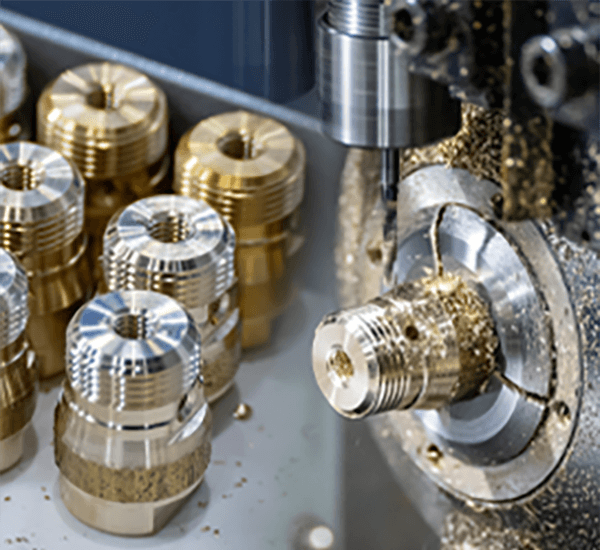
Attaining target exterior polish for a CNC part proves indispensable.
- Specification callouts prescribe the detailed finish for parts
- These callouts often use terms like "Ra," which stands for arithmetic mean deviation to quantify the surface roughness
- Appreciating callout details is key to ensuring product functionality
- Specified roughness affects lubricant distribution, frictional performance, and durability
- Careful reading of finish callouts enables achieving the planned outcome
CNC Machining — Precision Engineering Explained

CNC-driven fabrication functions as a modern manufacturing method using computerized programs to drive machines that cut complex shapes with high precision.
- CNC equipment supports building precise items from many material classes
- Broad CNC applicability benefits industries like aerospace, automotive, and healthcare
- G-code driven machining maintains reliable consistency across batches
Across R&D to production scale-up CNC machining drives manufacturing evolution
Interpreting CNC Specifications
Grasping machine spec language may feel tough at first
Even so practical familiarity and a systematic plan enable decoding machine specs
Open by noting essential values: spindle speed, feeds, accuracy, envelope, control type
All attributes together shape the system’s production performance.
Example: increased spindle revolutions aid soft materials; accelerated feed raises production.
Comprehending those interactions assists in picking the proper CNC for tasks
Always examine producer technical literature in detail.
Provided manuals commonly contain clarifying information and define jargon
Complete Overview of CNC Equipment
G-code driven machining centers are computer-run systems for precise automated production of varied materials They interpret CNC code instructions to command cutting tools and motion.
- Several forms of CNC equipment are mills, lathes, routers, plasma cutters
- Production processes accommodate metal alloys, plastics, woods, and composite materials
- In addition these machines facilitate quick prototyping and short-run manufacturing for startups and labs
CNC Machines: The Fundamentals Explained
CNC machines represent a remarkable fusion of mechanical precision and sophisticated software control Versatile machinery employs programmed code to autonomously produce simple parts and complex assemblies The basic principle involves transforming CAD models into real-world components.
- Computer Numerical Control machining
- Digital-to-physical process
It uses accurate motion sequences commanded by the controller Machine operators handle parameter selection, process monitoring, and quality confirmation.
Surface Finish Effects in CNC Production
Producing expected finish through machining is important It modifies operational efficiency and cosmetic finish The type of material being machined the cutting parameters used and the post-processing operations all contribute to the achieved surface texture.
High-quality surfaces strengthen durability while rough textures may reduce efficacy Code-driven machining enables selective tooling and techniques to attain required textures.
- By using distinct cutter geometries |carbide alloys|surface speed choices to reach texture
- Moreover post-machining steps like polishing or sanding improve surface quality
Comprehending the connections between machining choices and texture secures better results.
CNC Basics — Operation and Uses
Precision production uses machine control software to shape parts from different material classes They adhere to programmed code to reproduce complex geometries with repeatable accuracy Knowing programming basics and tool selection secures better machining outcomes
Industry applications include aircraft, automotive, medical, electronics, and beyond From fine aerospace pieces to intricate mold geometries, CNC underpins complex manufacturing
Specifying Surface Roughness for CNC Parts
Appropriate surface specification is essential during CNC part production It ensures part compliance with operational and appearance standards Engineers generally specify surface quality using the Ra roughness notation Measured in micrometers or inches, the number reflects mean surface roughness height.
Evaluate both finish smoothness targets and the operational application before specifying

Typically smoother finishes are chosen where tight dimensional control and alignment matter
More pronounced surface profiles help applications relying on friction or traction
Apply clear finish annotations in technical drawings to state desired texture Document the Ra value and enumerate any extra finishing or treatment instructions.
Keep in mind clear finish callouts are central to manufacturing success
Types of CNC Machines and Their Capabilities
Machine shops deploy varied CNC equipment tailored to many distinct production tasks They pair with CAD software to translate designs into cutting commands for precise fabrication.
- Drills bore precise holes with controlled feed and speed
- Turning machines rotate stock to create symmetrical components efficiently
- Plasma cutters employ ionized gas arcs to sever metal quickly and accurately
Select machinery by weighing material, complexity, and tolerance needs Specialized CNC abilities fulfill industry requirements across sectors from transport to healthcare.
Achieving Premium Surface Results in CNC Processes
Delivering optimal surface quality is necessary and CNC processes are well-suited to achieve it Through tailored feed rates spindle selection and tool design engineers control surface formation and limit imperfections Plus durable cutting materials and appropriate coolant control boost finish quality Strategic toolpath planning and precise machine adjustments result in superior finish quality.
CNC Programming to Achieve Surface Quality
Skillful CNC programming directly impacts the final surface quality Feed selection spindle rpm and cutter geometry collectively determine texture outcomes Precise setting selection and effective coolant control support high-quality finishes.
- Also ongoing tool care and inspection support sustained finish reliability Furthermore regular tool maintenance and inspection are essential for ensuring a consistent what is cnc and high-quality surface finish over time Plus regular inspection and maintenance of tools copyright finishing standards
- In order to refine finish consider material, target roughness, and end-use needs
- Toolpath simulation enables testing parameter impacts to cut down surface errors
- Besides that systematic tool upkeep and monitoring ensure sustained surface quality
